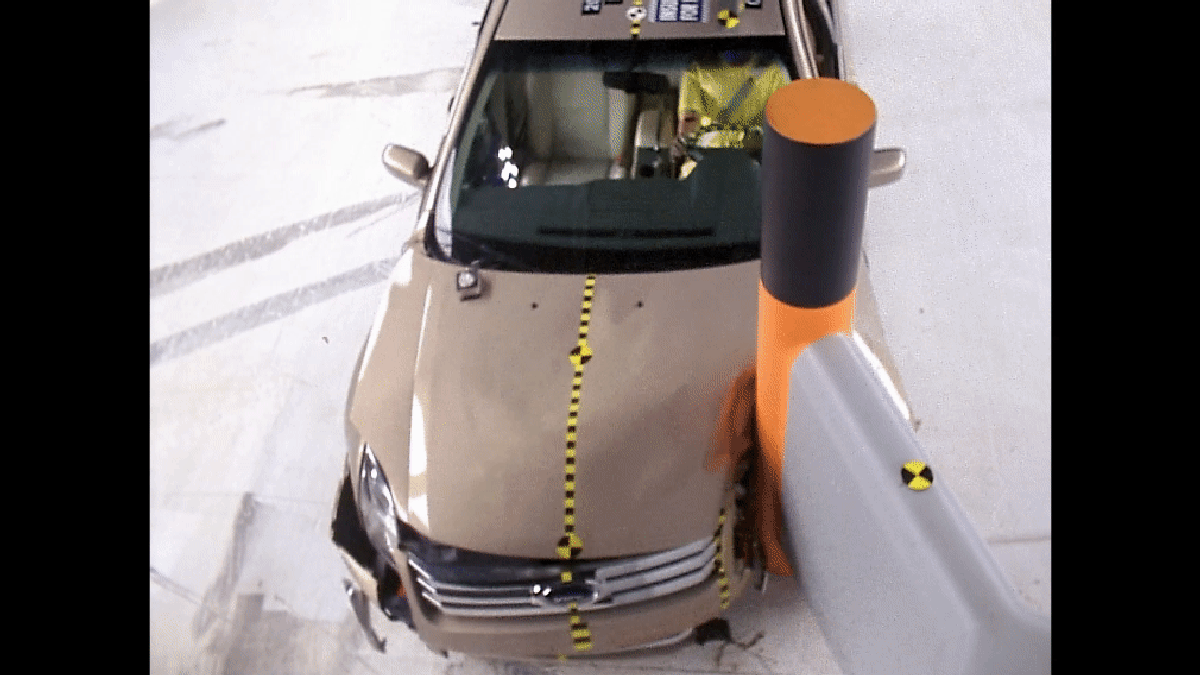The Insurance Institute for Highway Safety (IIHS) has been slamming cars into barriers in the name of science for nearly 30 years, and modern cars are much safer thanks to its efforts. I have been watching IIHS crash test videos on YouTube since I was a little kid, and before you ask, yes, my parents were concerned. I recently came across some videos posted online by a third party featuring an IIHS crash test that I had never seen before, so I decided to investigate.
These previously unpublicized videos from 2010 document research tests that were performed to determine the best way to introduce a new crash test that would evaluate cars in a small-overlap crash scenario, essentially potential alternatives to the IIHS’ now-standardized small-overlap crash test. In the late 2000s, data showed small-overlap crashes were the cause of a significant number of fatalities, and the IIHS was tipped off to this trend by Volvo, Saab, and Mercedes-Benz. To get the full scoop I spoke with IIHS Chief Research Officer David Zuby, who kindly provided Jalopnik with these development videos and allowed us to officially publish them for the first time.
Zuby says the IIHS started testing new cars in a small-overlap scenario because many automakers had already figured out how to produce cars that performed well in its moderate-overlap test, yet still had high fatality rates in the real world. Zuby, who has been with the IIHS for about 30 years, told me about the unique challenges posed by small-overlap testing, and described how identifying the best type of crash test to accurately recreate real-world crash scenarios required recreating contact points that accident investigators determined resulted in real-world injuries in on-road crashes.
The IIHS tried recreating crash scenarios where vehicles collided at an oblique angle, but this style of test was challenging to perform and recreate with accuracy due to unpredictable dummy movement, complicated preparation, and space constraints in its testing facility. It was ultimately deemed unnecessary since the IIHS’ small-overlap barrier test was also able to replicate the real-world crash scenarios accurately without the complexity of the car-to-car test.
These videos of vehicles colliding with a pole were another potential small-overlap testing procedure that the IIHS explored. Through performing these tests, the IIHS evaluated different pole sizes and levels of overlap, but eventually determined that the round surface of a pole requires extreme accuracy to recreate consistent results in its test center. The current small-overlap test involves a vehicle colliding with a rounded-edge barrier with only 25% of the vehicle making contact with the barrier. This test puts significantly more strain on a smaller portion of vehicle components when compared to a moderate or full-overlap test, thus requiring automakers to produce holistically stronger safety cages and overall safer vehicles.
Objectivity aside, the main reason I investigated the origin of these videos was because of the sheer carnage of the 2008 Ford Fusion’s dismal performance in the video I originally saw. The IIHS introduced the small-overlap crash test in 2012, so it never publicly put any pre-2012 cars through the small-overlap crash test. The vehicle offers virtually zero protection for the driver in this scenario, and once the Fusion finally stops peeling apart, the camera captures an unobstructed view of the entire crash test dummy through the gaping hole created by this test. I’ve never seen an IIHS crash test result in the driver being left so vulnerable.
I asked Zuby if the IIHS would consider putting older vehicles through the small-overlap crash test, and he said it wouldn’t make sense to do so given that the IIHS’ purpose is to encourage automakers to improve the safety of their new vehicles.
Zuby told me that a mark of the IIHS’ success is the original side-impact crash test. He said that in real-world crashes, drivers of vehicles that received the IIHS’ highest rating of good in the side-impact crash test had a 70-percent lower death rate than those in vehicles that received the IIHS’ lowest rating of poor. That statistic is somewhat morose, but it is palpable data that shows the IIHS’ tests really are representative of real-world crashes.
You can read up on the IIHS’ small-overlap crash test protocol here, and learn more about its other tests at the IIHS website. Zuby said that any new crash tests that the IIHS implements will serve to reduce accident fatalities by smaller margins, since its current array of crash tests and other systems tests already address major areas of most crash scenarios.
The IIHS introduced testing protocols to determine the efficacy of new vehicles’ advanced driver assistance systems like front crash prevention systems in 2013. It also introduced a headlight evaluation protocol, since about half of all fatal crashes happen at night, and most recently it began evaluating vehicles’ seatbelt reminder notifications as the small number of unbelted drivers account for an outsized portion of people who are killed in crashes. The IIHS is also updating its testing procedures to remain representative of the modern automotive landscape by increasing the weight of the sled that is used in side-impact crash tests, as the average size and weight of new vehicles has risen.
The IIHS’ extensive testing publicly holds automakers accountable for the safety of their new vehicles, and thanks in part to its work, modern automobiles are exponentially safer than their predecessors.

